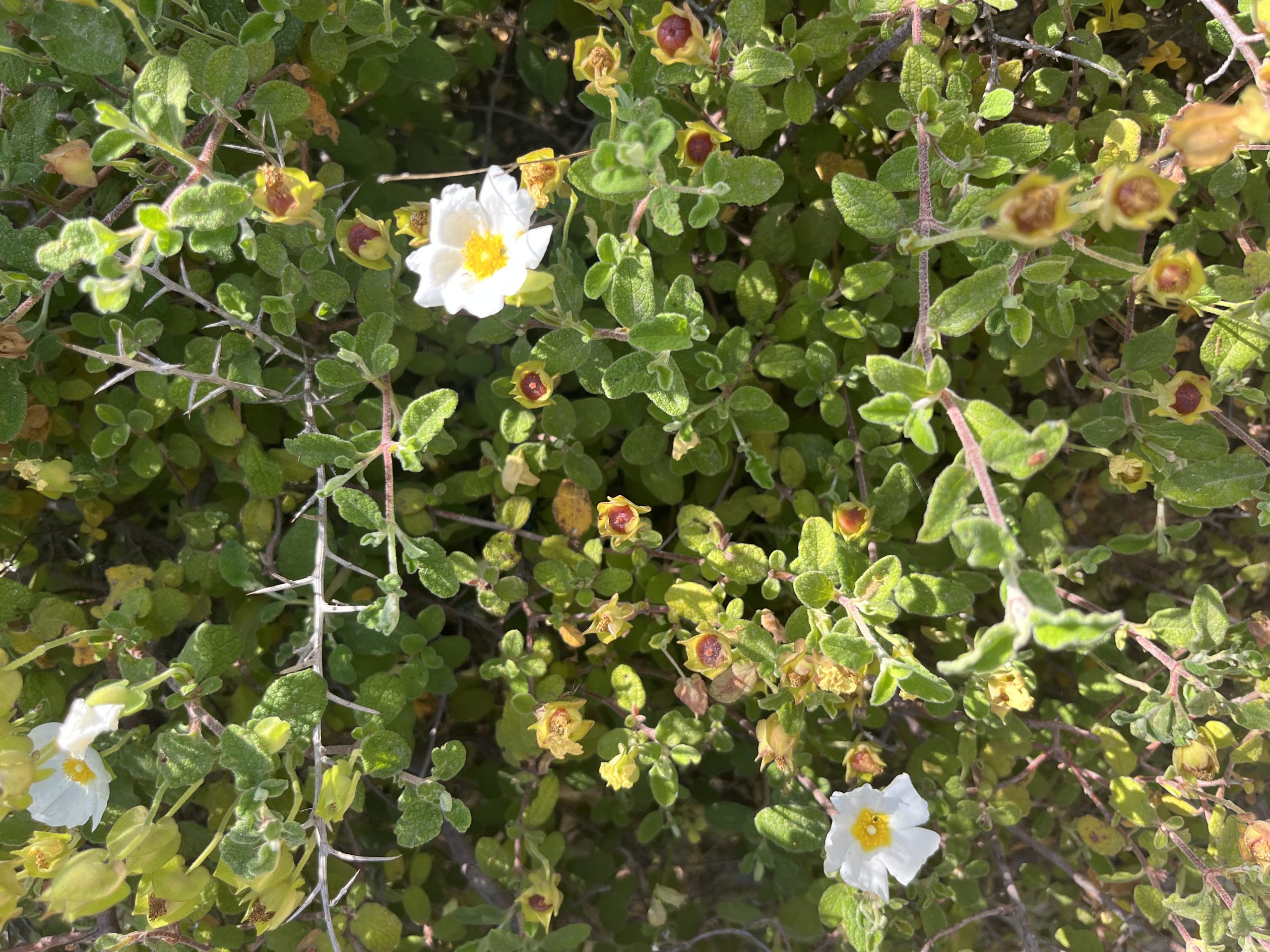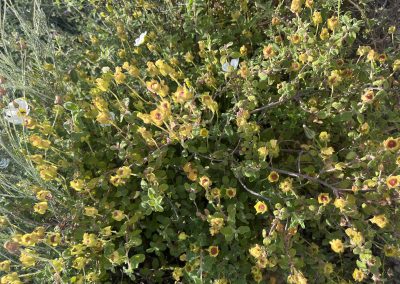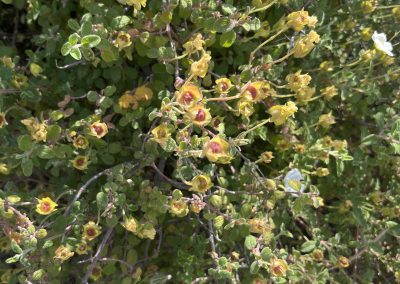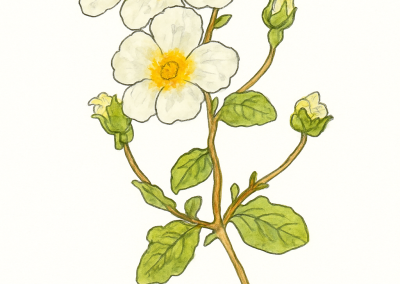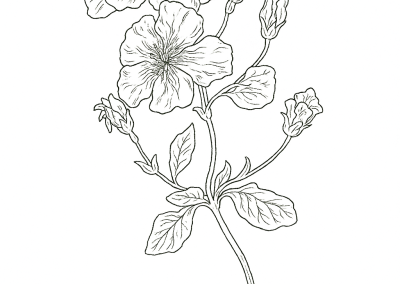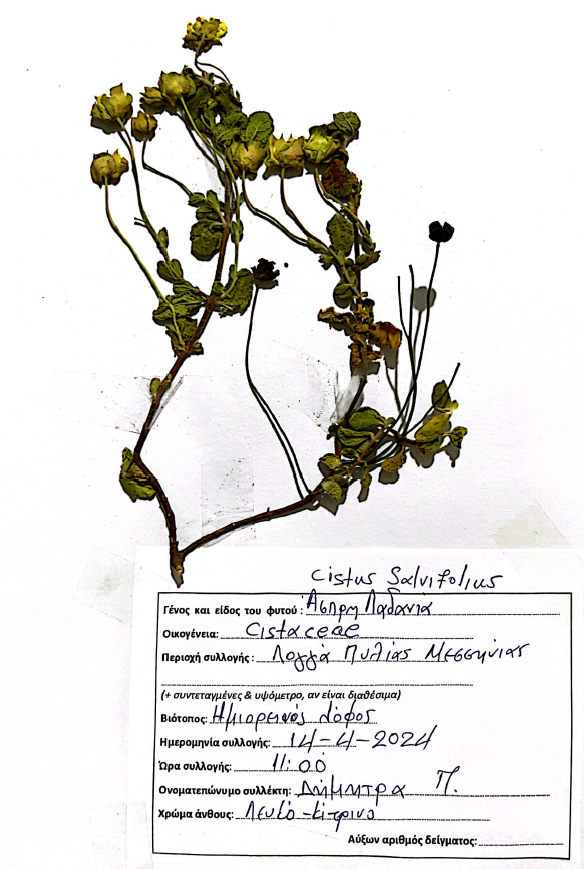Cistus salvifolious
Scientific description
Scientific name: Cistus salvifolius
Common name: Sage-leaved Rockrose
Kingdom: Plantae
Phylum: Tracheophyta
Class: Magnoliopsida
Order: Malvales
Family: Cistaceae
Genus: Cistus
Species: Cistus salvifolius
Origin:
Native to the Mediterranean Basin.
Description:
Evergreen shrub up to 1 m tall, with grey-green sage-like leaves. Flowers are white, 4–6 cm in diameter, with a yellow center, blooming in spring.
Propagation:
By seeds (often germinating after fire) or cuttings.
Ecology:
Adapted to dry, rocky soils and full sun. Fire-adapted species contributing to Mediterranean scrubland ecosystems. Pollinated by insects.
Usage:
Ornamental in Mediterranean gardens. Ecological role in soil stabilization and biodiversity.
Επιστημονική ονομασία: Cistus salvifolius
Κοινή ονομασία: Λαδανιά με φύλλα φασκόμηλου
Βασίλειο: Φυτά
Φύλο: Τραχεόφυτα
Κλάση: Δικοτυλήδονα (Magnoliopsida)
Τάξη: Malvales
Οικογένεια: Cistaceae
Γένος: Cistus
Είδος: Cistus salvifolius
Καταγωγή:
Ενδημικό στη Μεσογειακή λεκάνη.
Περιγραφή:
Αειθαλής θάμνος έως 1 μ., με φύλλα γκριζοπράσινα, όμοια με φασκόμηλο. Άνθη λευκά, 4–6 εκ., με κίτρινο κέντρο, ανθίζουν την άνοιξη.
Πολλαπλασιασμός:
Με σπόρους (συχνά βλαστάνουν μετά από φωτιά) ή μοσχεύματα.
Οικολογία:
Προσαρμοσμένο σε ξηρά, βραχώδη εδάφη και πλήρη ήλιο. Είδος προσαρμοσμένο στη φωτιά, σημαντικό για τα μεσογειακά οικοσυστήματα. Επικονιάζεται από έντομα.
Χρήση:
Διακοσμητικό σε μεσογειακούς κήπους. Οικολογικός ρόλος στη σταθεροποίηση εδαφών και στη βιοποικιλότητα.
Nom scientifique : Cistus salvifolius
Nom commun : Ciste à feuilles de sauge
Règne : Plantae
Phylum : Tracheophyta
Classe : Magnoliopsida
Ordre : Malvales
Famille : Cistaceae
Genre : Cistus
Espèce : Cistus salvifolius
Origine :
Originaire du bassin méditerranéen.
Description :
Arbuste persistant atteignant 1 m, feuilles gris-vert ressemblant à la sauge. Fleurs blanches de 4–6 cm avec centre jaune, au printemps.
Propagation :
Par graines (souvent après incendie) ou boutures.
Écologie :
Adapté aux sols secs, rocheux et au plein soleil. Espèce adaptée au feu, joue un rôle clé dans le maquis méditerranéen. Pollinisé par les insectes.
Usages :
Ornemental dans les jardins méditerranéens. Stabilisation des sols et soutien de la biodiversité.
Denumire științifică: Cistus salvifolius
Denumire comună: Lădăniță cu frunze de salvie
Regn: Plantae
Încrengătură: Tracheophyta
Clasă: Magnoliopsida
Ordin: Malvales
Familie: Cistaceae
Gen: Cistus
Specie: Cistus salvifolius
Origine:
Nativă bazinului mediteranean.
Descriere:
Arbust veșnic verde, până la 1 m, cu frunze gri-verzi asemănătoare salviei. Flori albe, 4–6 cm, cu centru galben, primăvara.
Înmulțire:
Prin semințe (germinează adesea după incendii) sau butași.
Ecologie:
Adaptată la soluri uscate, pietroase și plin soare. Specie adaptată la foc, importantă în ecosistemele de tip maquis mediteranean. Polenizată de insecte.
Utilizare:
Ornamentală în grădini mediteraneene. Contribuie la stabilizarea solului și la menținerea biodiversității.
Creative writing inspired by Cistus salvifolious
Cistus salviifolius — The White Rockrose
In a distant land, there lived two siblings, Helios and Selene, children of the sky and the earth. Though inseparable, each had a distinct purpose. Helios lit up the day with his warm light, while Selene softly illuminated the night, guiding travelers through the darkness.
One day, Selene fell in love with a young mortal named Lykano, who lived on the hills and was known for his kindness and deep love of nature. However, as a goddess, she could not be with him, and this love caused her great sorrow. Selene asked her brother, Helios, to allow her to see him during the day. Helios agreed, but only for a short time.
One day, as Selene watched Lykano from above, she saw that he had fallen seriously ill. Desperate, she descended to earth to help him, but the gods punished her for defying the natural order, condemning her to never return to the sky. To save her beloved, Selene sacrificed her celestial existence and transformed into a plant with white flowers, the white rockrose, so that she could forever remain close to Lykano, offering him protection and healing.
The plant’s fragrance and medicinal properties were seen as Selene’s gift, who sacrificed her divine self for love. Its white flowers symbolize the purity of her love and the power of sacrifice.


